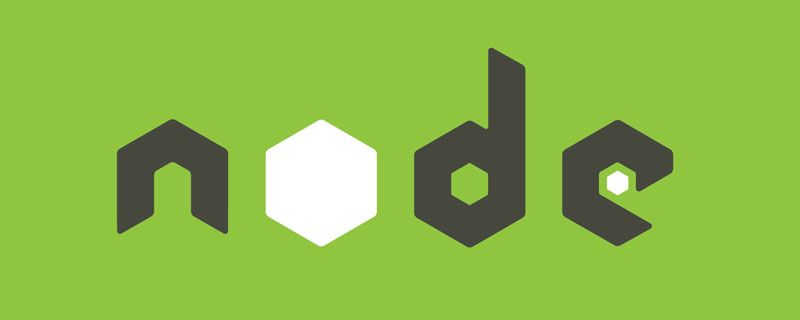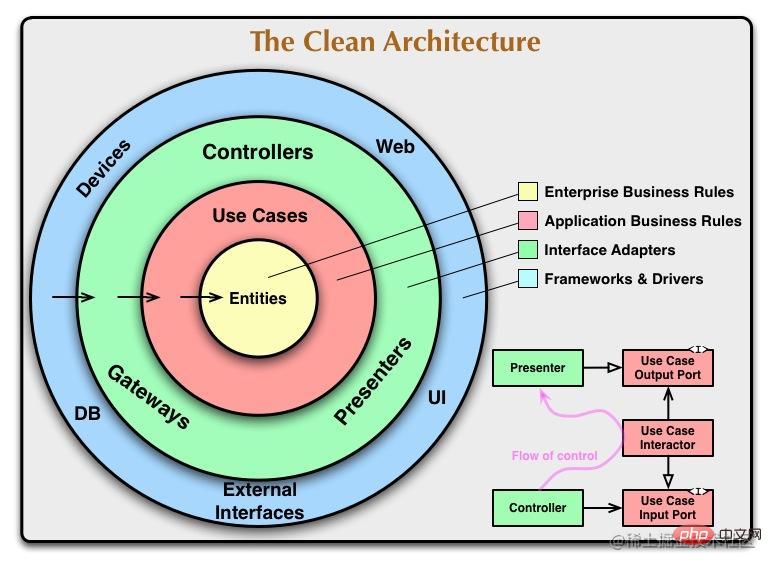Clean Architecture是什么?本篇文章帶大家了解一下Clean Architecture,并聊聊使用Node.js實(shí)現(xiàn)Clean Architecture的方法,希望對(duì)大家有所幫助!

Clean Architecture
Clean Architecture 是 Robert C. Martin 提出的一種軟件架構(gòu)模式,目的是為了將系統(tǒng)分層,實(shí)現(xiàn)關(guān)注點(diǎn)分離,使系統(tǒng)更易于理解、維護(hù)和擴(kuò)展。該體系結(jié)構(gòu)將系統(tǒng)分為四個(gè)層級(jí),從內(nèi)到外分別是:實(shí)體層、用例層、表現(xiàn)層、基礎(chǔ)設(shè)施(存儲(chǔ)庫,框架等)。

在本文中,我們將介紹如何使用 Node.js 實(shí)現(xiàn) Clean Architecture,并提供一些示例代碼來演示該架構(gòu)的關(guān)鍵概念。
接下來我們將使用 TypeScript 項(xiàng)目示例(github.com/lulusir/cle… )。該項(xiàng)目采用了 Monorepo 結(jié)構(gòu),使用 Rush.js 進(jìn)行管理。在 server 文件夾中包含了三個(gè)子項(xiàng)目,分別為 core、koa 和 nestjs-app,其中 core 為核心業(yè)務(wù)邏輯,koa是使用koa+prisma的為底層框架web項(xiàng)目,nestjs-app是使用nestjs + typeorm為底層框架的項(xiàng)目。目的是演示相同的業(yè)務(wù)邏輯如何橋接不同的框架。【相關(guān)教程推薦:nodejs視頻教程、編程教學(xué)】
在這個(gè)項(xiàng)目中,實(shí)體層包含實(shí)體對(duì)象和相關(guān)的業(yè)務(wù)規(guī)則和邏輯,用例層包含系統(tǒng)的用例和業(yè)務(wù)邏輯,存儲(chǔ)庫層負(fù)責(zé)保存和檢索數(shù)據(jù),表示層則是暴露給外部的http接口。
項(xiàng)目功能:
實(shí)現(xiàn)一個(gè)帖子發(fā)布,瀏覽功能
-
用戶創(chuàng)建,查詢
-
帖子的發(fā)布,編輯,查詢,刪除
項(xiàng)目結(jié)構(gòu)
├── server │ ├── core // 核心業(yè)務(wù)邏輯 │ │ └── src │ │ ├── domain │ │ ├── repository │ │ └── useCase │ ├── koa │ │ └── src │ │ ├── post │ │ └── user │ └── nestjs-app │ ├── src │ ├── post │ │ ├── dto │ │ └── entities │ └── user │ └── entities └── web
-
core:core為核心業(yè)務(wù)邏輯的代碼
- Domain: 存放實(shí)體相關(guān)的代碼,如業(yè)務(wù)具體的 model 等
- Use Cases: 存放業(yè)務(wù)邏輯相關(guān)的代碼,如處理業(yè)務(wù)邏輯、數(shù)據(jù)驗(yàn)證、調(diào)用 Repository 等
- Repository: 存放和外部存儲(chǔ)系統(tǒng)的相關(guān)接口
-
koa/nestjs-app: core的實(shí)際消費(fèi)者
- 根據(jù)core的接口實(shí)現(xiàn)具體的Router,Repository
項(xiàng)目特點(diǎn)
- 使用 DDD 和 Clean Architecture 的思想,將業(yè)務(wù)邏輯與框架實(shí)現(xiàn)分離。
- 使用 monorepo 項(xiàng)目結(jié)構(gòu),方便管理多個(gè)相關(guān)的項(xiàng)目。
- 提供了多個(gè)示例應(yīng)用程序,方便快速上手。
- 基于 TypeScript,提高代碼可讀性和可維護(hù)性。
在core中,我們有核心的業(yè)務(wù)邏輯代碼。此級(jí)別包含域、存儲(chǔ)庫接口和用例。域包含與實(shí)體相關(guān)的代碼,例如特定的業(yè)務(wù)模型。存儲(chǔ)庫包含與外部存儲(chǔ)系統(tǒng)的相關(guān)接口。用例包含與業(yè)務(wù)邏輯相關(guān)的代碼,例如處理業(yè)務(wù)邏輯、數(shù)據(jù)驗(yàn)證和調(diào)用存儲(chǔ)庫。
在koa/nestjs-app層面,我們有核心層面的實(shí)際消費(fèi)者。它們根據(jù)核心層提供的接口實(shí)現(xiàn)特定的路由器和存儲(chǔ)庫。 使用 Clean Architecture 的主要優(yōu)點(diǎn)之一是它將業(yè)務(wù)邏輯與技術(shù)實(shí)現(xiàn)分開。這意味著您可以輕松地在不同的框架和庫之間切換,而無需更改核心業(yè)務(wù)邏輯。在我們的示例中,我們可以在 koa 和 nestjs-app 之間切換,同時(shí)保持相同的核心業(yè)務(wù)邏輯。
代碼實(shí)現(xiàn)
定義實(shí)體層
// server/core/src/domain/post.ts import { User } from "./user"; export class Post { author: User | null = null; content: string = ""; updateAt: Date = new Date(); // timestamp; createdAt: Date = new Date(); // timestamp; title: string = ""; id: number = -1; } // server/core/src/domain/user.ts export class User { name: string = '' email: string = '' id: number = -1 }
定義存儲(chǔ)接口
import { Post } from "../domain/post"; export interface IPostRepository { create(post: Post): Promise<boolean>; find(id: number): Promise<Post>; update(post: Post): Promise<boolean>; delete(post: Post): Promise<boolean>; findMany(options: { authorId: number }): Promise<Post[]>; } ... import { User } from "../domain/user"; export interface IUserRepository { create(user: User): Promise<boolean>; find(id: number): Promise<User>; }
定義用例層
import { User } from "../domain/user"; import { IUserRepository } from "../repository/user"; export class UCUser { constructor(public userRepo: IUserRepository) {} find(id: number) { return this.userRepo.find(id); } create(name: string, email: string) { if (email.includes("@test.com")) { const user = new User(); user.email = email; user.name = name; return this.userRepo.create(user); } throw Error("Please use legal email"); } }
koa項(xiàng)目
在koa項(xiàng)目中實(shí)現(xiàn)存儲(chǔ)層接口
// server/koa/src/user/user.repo.ts import { PrismaClient } from "@prisma/client"; import { IUserRepository, User } from "core"; export class UserRepository implements IUserRepository { prisma = new PrismaClient(); async create(user: User): Promise<boolean> { const d = await this.prisma.user_orm_entity.create({ data: { email: user.email, name: user.name, }, }); return !!d; } async find(id: number): Promise<User> { const d = await this.prisma.user_orm_entity.findFirst({ where: { id: id, }, }); if (d) { const u = new User(); u.email = d?.email; u.id = d?.id; u.name = d?.name; return u; } throw Error("user id " + id + "not found"); } }
在koa項(xiàng)目中實(shí)現(xiàn)HTTP路由(表現(xiàn)層)
// server/koa/src/user/user.controller.ts import Router from "@koa/router"; import { UCUser } from "core"; import { UserRepository } from "./user.repo"; export const userRouter = new Router({ prefix: "/user", }); userRouter.get("/:id", async (ctx, next) => { try { const service = new UCUser(new UserRepository()); if (ctx.params.id) { const u = await service.find(+ctx.params.id); ctx.response.body = JSON.stringify(u); } } catch (e) { ctx.throw(400, "some error on get user", e.message); } await next(); });
nest-js項(xiàng)目
nestjs 項(xiàng)目的示例可以在此路徑中找到 (github.com/lulusir/cle…就不在這里貼代碼了
最后
請(qǐng)注意,在實(shí)際項(xiàng)目中,我們不會(huì)將核心業(yè)務(wù)邏輯放在單獨(dú)的倉庫中(即core),這只是為了演示在不同框架下使用相同的業(yè)務(wù)邏輯
通過將業(yè)務(wù)邏輯與框架分離,您可以輕松地在不同的框架和庫之間切換,而無需更改核心業(yè)務(wù)邏輯。如果您希望構(gòu)建可擴(kuò)展且可維護(hù)的應(yīng)用程序,那么Clean Architecture 絕對(duì)值得考慮。
如果想要演示如何接入其他框架,可以在評(píng)論區(qū)提出
項(xiàng)目地址 (github.com/lulusir/cle… 覺得不錯(cuò)的小伙伴,可以給個(gè)star,謝謝
 站長資訊網(wǎng)
站長資訊網(wǎng)